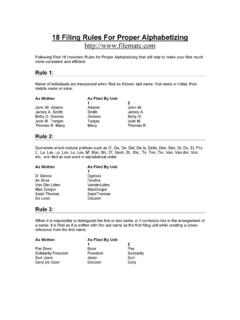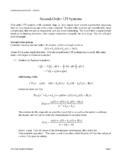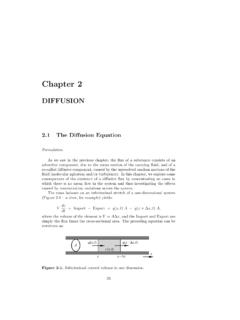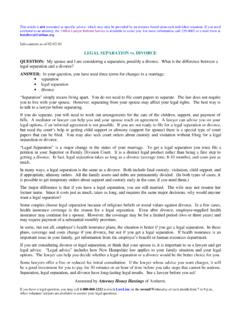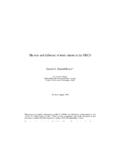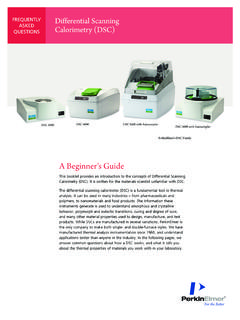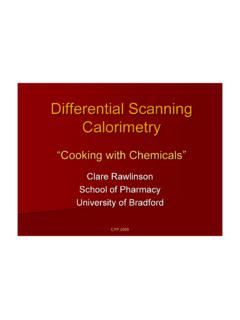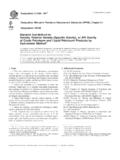Transcription of Phase Transitions and Differential Scanning …
1 Chemistry 75 Winter, 2010 Phase Transitions and Differential Scanning CalorimetryPage 1 Phase Transitions and Differential Scanning CalorimetryOverviewDifferential Scanning calorimetry (DSC) is an inexpensive and rapid method to measure heatcapacities of condensed phases . From these measuremenmst, enthalpy changes for phasetransitions can easily be determined. DSC has been applied to a wide variety of problems, fromcoal combustion to protein this experiment, we will begin with a standard reference substance, indium, and thenexamine several types of materials: an inorganic salt (NH4Cl), the polymer polyethylene, and twoliquid crystals: p-azoxyanisole, and cholesterylmyristate. Ammonium chloride has been studiedfor several years and is now considered to provide an excellent example of solid structural phasetransitions. It has two such Transitions , at 242 K and 457 K.
2 The enthalpy change of the transitionat 457 K can be measured to within a few percent. However, so far, we have only an estimate for H for the transition at 242 K; we will study only the higher temperature one of the two next part of this experiment consists of determining the percent crystallinity in a sampleof the polymer polyethylene. Our polyethylene sample melts at about 386 K. By computing theenthalpy change of melting of a completely crystalline sample, we can compute the liquid crystal p-azoxyanisole exhibits two Transitions (the normal solid to the so-callednematic liquid-crystal Phase and the nematic to the normal or isotropic liquid) within an accessibletemperature range. Similarly, cholesterylmyristate exhibits several Transitions of its provides a convenient and moderately accurate method of measuring heat capacities andenthalpy changes.
3 Commercial instruments provide a recorder output of the constant-pressure heatcapacity,CP = dqdTP = H TP as a function of temperature. The area under such a curve between any two temperature limitsyields an enthalpy change: H = H TP dTT1T2 = CP dTT1T2 The Differential Scanning calorimeter operates on the null balance principle. Within theassembly there are two small sample holders: one for the sample and the other to hold a referencematerial. Energy (as electrical work) is supplied to each sample holder independently, and theChemistry 75 Winter, 2010 Phase Transitions and Differential Scanning CalorimetryPage 2temperatures of each are monitored. Energy (as an associated heat) which is absorbed or evolvedby the sample is compensated by increasing or decreasing the electrical energy delivered to thesample-holder heater. The temperatures are monitored by comparing the respective signals fromplatinum resistance thermometers in each of the sample holders.
4 This adjustment of electrical inputto the heating unit provides a varying electrical signal which is opposite but equivalent to thevarying thermal behavior of the sample. For example, when a Phase transition point is reachedfrom lower temperatures, the sample will absorb additional energy. Then additional electricalpower must be supplied to the heater of this sample so that the reference and sample holders will beat the same temperature. When the transition is completed, the temperature of the sample will rise,and additional heat need no longer be supplied. The varying electrical signal thus provides a recordof the thermal behavior of the this experiment several different types of Phase Transitions in one-component systems willbe observed. Under ideal conditions common Phase changes ( , solid-to-liquid, liquid-to-gas,etc.)
5 Occur, under a given constant pressure, entirely at a single temperature, at which the apparentheat capacity is infinite. The sharp spike in CP at the transition temperature is an example of a so-called delta function, defined to be zero except at one value of its independent variable where itbecomes infinite, but with a definite finite area beneath it (in our case, the enthalpy change for thetransition). The sharp spike to infinity in CP at the transition temperature cannot be observed inpractice. Often the system may contain impurities or may be slightly non-uniform in structure;furthermore, the rate of transfer of heat through the system is not zero, so that different parts of thesystem cannot all have exactly the same temperature; and finally, all Phase Transitions occur at lessthan infinite rates. For these reasons, the experimental CP T curve displays a broader peak, andthe enthalpy change H for the transition is taken as the area under the peak (see Figure 1).
6 Thenominal transition temperature is often taken as the point at which the curve first rises from thebase line; alternatively, if the peak is very sharp, the temperature at the maximum can be 1 Chemistry 75 Winter, 2010 Phase Transitions and Differential Scanning CalorimetryPage 3 Melting TransitionsIn the first run, the melting of indium metal at 429 K will be observed and used as acalibration for the instrument, since its enthalpy of fusion per gram is well known ( H = Jg 1). Thus the area under a CP vs. T curve for an unknown sample can be converted into energyunits by comparison to the In second melting transition to study is that in a sample of polyethylene:(CH2)n(s) (CH2)n(l)Under ideal conditions a completely crystalline sample of the polymer would be used, and it wouldpresumably have a more or less sharp melting point, like any other crystal.
7 However, realpolymers cannot be obtained in 100% crystalline form, because of their long-chain regions of entangled chains inevitably are produced when the material is cooled downfrom the melt, and the typical crystallites may be only 20 or 30 nm in dimension. When thepolymer is heated, melting takes place over a broader range of temperatures, as in Figure 1, and thearea under the curve can be used as a measure of the degree of crystallinity in the sample, providedwe can somehow get a value of the specific enthalpy of fusion per gram of crystal. Fortunately,the Clapeyron equation (Engel and Reid, eq. ) comes to our aid! The melting temperature as afunction of pressure can be determined, its slope can be measured and used to determine dP/dT;the value of V can be obtained from a combination of the measured density of the melt (the liquidphase) and the crystal unit-cell dimensions as observed by X-ray diffraction.
8 From these data, avalue of 286 J g 1 has been found for the specific enthalpy of fusion of crystalline melting temperature of an ideal crystal of the polymer has been estimated to lie at about 418 K,but for various reasons the observable melting range usually lies well below this Transitions in Ammonium ChlorideSolid ammonium chloride is an ionic substance that can exist in several different crystalstructures. Phase I, which is stable above K, is a cubic crystal which resembles commonNaCl: each chloride ion is surrounded by six nearest neighbor ammonium ions, and in turn eachNH4+ ion is surrounded by six chlorides. Below the transition temperatures quoted above thestable Phase II is again cubic, but it now resembles CsCl: each NH4+ has eight Cl nearestneighbors, and vice between such different crystal structures are quite common, and are generallyalso of the sharp type called first order.
9 However, they may take a longer time to occur, and sothere is some danger of superheating or supercooling. You should be able to get fairly good valuesof the transition temperature and of H for the change in stateNH4Cl(s, II) NH4Cl(s, I) T = K, P = 1 atmChemistry 75 Winter, 2010 Phase Transitions and Differential Scanning CalorimetryPage 4 Transitions in Liquid CrystalsWhen most solids melt the atoms or molecules become much freer to move around the spaceoccupied by the material, and also (where applicable) gain the freedom to orient themselves inmany different ways. Thus, molecules lose both positional and orientational order in the transitionfrom solid to liquid, and the entropy of the system increases. In liquid crystals there are one ormore states which lie between the solid and the liquid, associated with varying degrees oforientational and translational order.
10 For example, in p-azoxyanisole (PAA) (shown below) thereis a solid-to-liquid crystal Phase change at 391 K, and then the transition to the normal liquidfollows at 408 + By determining the enthalpy change associated with each of the Transitions you should beable to deduce whether the liquid crystal Phase resembles more closely that of the solid or kinds of liquid crystal phases are possible, depending on the system. For rod-likemolecules, such as those studied here, these are labeled by characterizing the direction of preferedorientation and also by the tendancy to form layers. A good system in which to study transitionsbetween liquid crystal phases is cholesterylmyristate:OOC13H27 This material exhibits a solid-to-smectic-A transition at 344 K, a smectic-A-to-chiral-nematictransition at 352 K and then the transition to the normal liquid at 358 K, all easily accessible to crystals are classified into three structural types based on broad classes of order:(1) nematic: translationally disordered but orientationally ordered(2) smectic: translationally ordered in one dimension (yielding a system of layers of twodimensional liquids with a well-defined layer spacing) and orientationally ordered in the layers (atleast)(3) cholesteric: orientationally ordered like a nematic, but with a helical twist to thedirection of orientation.

